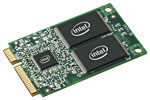Investigating Intel's Turbo Memory: Does it really work?
by Anand Lal Shimpi on June 19, 2007 3:39 PM EST- Posted in
- Laptops
Understanding Turbo Memory: It isn't as clear as you'd think
 Before we can accurately gauge the effectiveness or ineffectiveness of Intel's Turbo Memory, we have to be sure we understand exactly what it is supposed to do. Intel's Turbo Memory is on-motherboard flash split into two partitions: one for ReadyDrive and one for ReadyBoost. Turbo Memory is offered in two flavors, 1GB and 512MB, with 512MB and 256MB partitions respectively.
Before we can accurately gauge the effectiveness or ineffectiveness of Intel's Turbo Memory, we have to be sure we understand exactly what it is supposed to do. Intel's Turbo Memory is on-motherboard flash split into two partitions: one for ReadyDrive and one for ReadyBoost. Turbo Memory is offered in two flavors, 1GB and 512MB, with 512MB and 256MB partitions respectively.
The ReadyDrive portion of Turbo Memory is designed to work with Vista's ReadyDrive technology. ReadyDrive's fundamental goal is to cache data from the hard disk to either improve performance or in the case of a notebook, improve battery life. The primary role of ReadyDrive with Turbo Memory in a notebook, is to increase battery life.
ReadyDrive can increase battery life by fulfilling data request out of low power flash memory, and keeping the hard disk spun down when not needed. If enough data is stored in the ReadyDrive partition of Intel's Turbo Memory, the hard drive can remain spun down for significant periods of time, thereby improving overall battery life. Obviously the success of ReadyDrive depends on its ability to correctly prefetch the right data into Turbo Memory's cache, but if it works, the battery savings could be significant.
The hard drive in our test system is a Hitachi Travelstar 7K100, which draws anywhere from 0.9W to 1.2W on average when simply spinning and not accessing data. In its lowest power mode, the 7K100 draws only 0.2W, so if we can keep the drive spun down the total system power savings are in the 0.7W - 1W range. If the drive is seeking for data, power consumption is almost 3W, and actually reading data off of the drive eats up 2.3W. If the data can be instead read from low power flash memory, the power savings could be tremendous.
Intel once stated that every watt of system power you can shave off can net as much as 20 - 30 extra minutes of battery life, meaning ReadyDrive with Turbo Memory can yield a measurable increase in battery life. The reality is that 512MB of flash memory isn't enough to keep the hard drive spun down 100% of the time, so the real question is how much of an impact will there be under real world usage? We'll be answering that question shortly, but now let's look at what Turbo Memory intends to do for ReadyBoost.
Taken from our Windows Vista Performance Guide:
ReadyBoost functions as a compliment to SuperFetch, giving SuperFetch another place to cache data that - while not as good as RAM - is better than just reading data off of the hard drive. An important distinction however is that while RAM is both quick to access and has high transfer rates, flash memory only offers quick access times, with transfer rates below that of even hard drives. As a result ReadyBoost is only useful in situations where small random data accesses are required, whereas larger transfers that may need sequential access are sent directly to the hard drive. This makes ReadyBoost less readily beneficial than SuperFetch, but with USB flash drives going for under $20/gigabyte, it's a cheap and effective way to boost performance of RAM-limited computers in a number of situations.
ReadyBoost also serves as a read cache of the system pagefile, with the idea that swapping to disk is less painful if it's done to a USB flash drive. Don't worry about sensitive data being kept and lost on your USB drive though; the data is compressed and encrypted so that it should be fairly useless once the drive is removed from use.
The point of ReadyBoost is to make things faster when you run out of memory, but is Turbo Memory any faster/better than simply using an external USB drive? The one advantage Turbo Memory has for ReadyBoost over an external USB drive is that the data stored in the ReadyBoost partition remains persistent through hibernation. In a normal system with a USB drive being used for ReadyBoost, if you hibernate the machine, the ReadyBoost data on the USB drive is invalidated because the USB drive could have been removed/tampered with and Vista can no longer count on the integrity of that data. Turbo Memory does not have that problem as the flash is on the motherboard and can't easily be removed on the fly, thus Vista will keep ReadyBoost data persistent in its flash when coming out of hibernate. The benefit being that any data cached via ReadyBoost will be accessible coming out of hibernate, which simply isn't true when not using Turbo Memory. This is the only advantage of Turbo Memory with respect to ReadyBoost, and understanding that will help you understand when/where it will make an impact on system usage.










31 Comments
View All Comments
tuteja1986 - Wednesday, June 20, 2007 - link
Gigabyte i-ram now that was revoltionary in speed wise :) . I have it and i love it but it ain't cheap :( $120 for the i-ram and $200 for 4x 4GB DDR 1 PC3200.